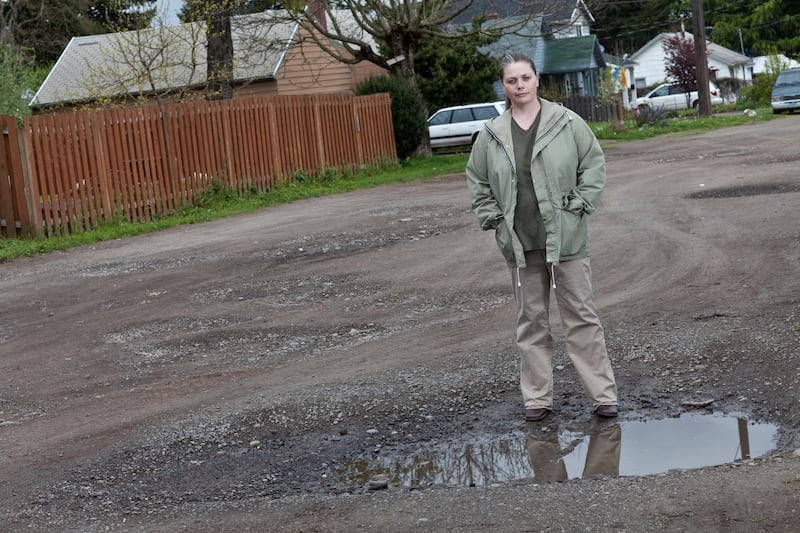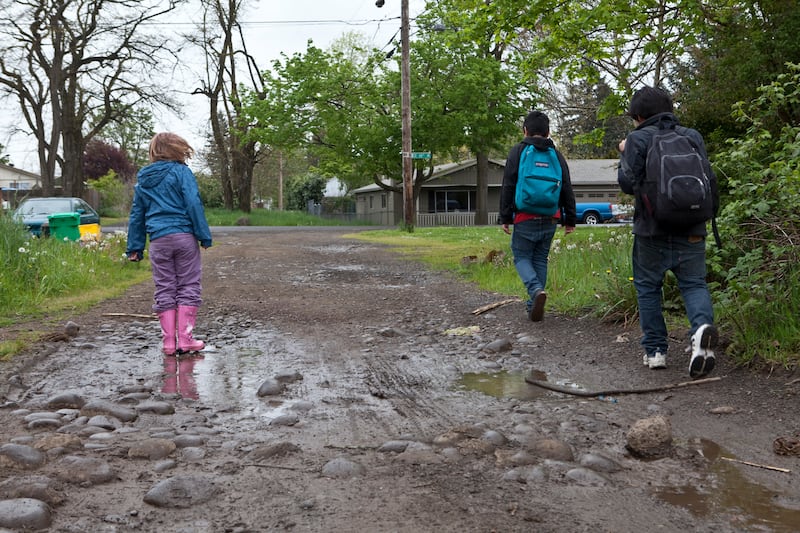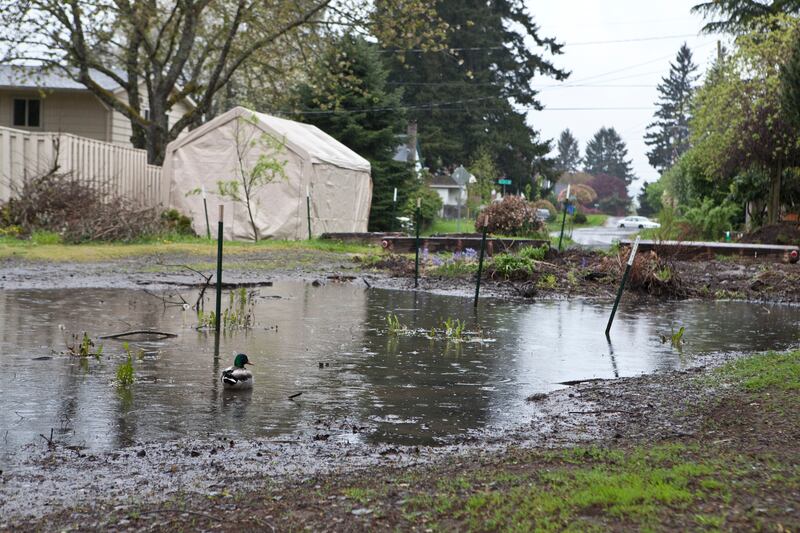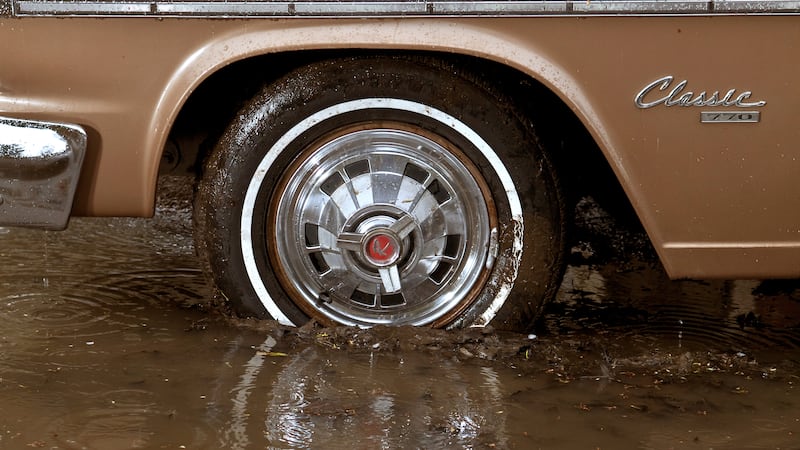This week, we asked WW readers to send us photos of the biggest potholes in their neighborhood streets. Many have sent photos of the ruts and ponds on unimproved dirt roads—wondering why the city won’t fix them. That’s not a new mess. In 2011, we counted 59 miles of unpaved streets in the city.
This story first ran in the May 11, 2010, issue of WW.
Last week, Mayor Sam Adams provided reporters a peek at his proposed city budget, which is set for a City Council vote on June 16.
The mayor points with pride to the city’s sound fiscal health. It’s a note he struck in February during his State of the City speech, when he said Portland is “now in better shape than other cities as we move out of the recession.”
And with Portland’s coffers full, the mayor, who will no doubt launch his re-election campaign later this year, presented a good-times budget that doles out sweets to a variety of constituencies.
Adams’ proposed budget would give half a million dollars for college scholarships, $300,000 to fix high-school sports fields, $100,000 to the Black Parent Initiative, $100,000 to the Oregon Food Bank and $100,000 for after-school programs.
“We’re able to make investments in our future today,” Adams said in his State of the City speech, describing Portland as a city “where all neighborhoods are complete, connected and beautiful.”
Not according to Laura Young.

Young lives in Cully, a neighborhood in Northeast Portland. Her beef? More than 10 percent of Cully’s streets are unpaved dirt roads. In the morning, she sends her son off to school along streets that make Portland look more like Port au Prince. The potholes in Cully’s dirt roads are so appalling, neighbors have filled them in with piles of bricks, sod and even firewood.
“We pay taxes like everyone else,” says Young, the transportation chair for the Cully Association of Neighbors. “This shouldn’t be happening.”
Portland may pride itself on livability and transportation, but it has a shameful secret: 59 miles of unpaved dirt and gravel roads. That’s more than three times as much as in Nashville, Boise, Seattle, Sacramento, Las Vegas, Atlanta, Denver, Minneapolis, Boston, Austin and San Francisco—combined.
“It’s definitely Third World,” says Lynn Partin, a lawyer who’s been active in city politics for years. “I’ve been to Mexico City. I guess that would be the closest.”
While close-in neighborhoods sport bioswales and bike boulevards, poorer quarters like Lents, Powellhurst and Brentwood-Darlington suffer the worst of Portland’s pothole plague. The loose dirt litters the air and water, and the rutted streets pose hazardous barriers to kids, the elderly and the disabled.
“It’s totally unacceptable,” says state Sen. Rod Monroe (D-East Portland). “There is just no reason in my mind that these streets should not have been paved by now.”
It might be defensible if Portland were short on cash. It might be excusable if members of the City Council, when they were candidates, hadn’t promised to pave those streets.
Neither is the case.
On a Tuesday morning in October 2008, with the general election just three weeks away, City Council candidates Amanda Fritz and Charles Lewis visited a retirement home in outer Southeast to meet the East Portland Chamber of Commerce.
It didn’t take long for Fritz—who eventually won the race—to bring up unpaved roads. It’s a perennial talking point when city candidates find themselves east of Mount Tabor.
Fritz railed about a recent announcement that City Hall had a $39 million budget surplus. Some of that money was spent on the arts, social services and even public tennis programs.
“It’s not a surplus,” Fritz insisted. “It is money that could have and should have been used to pave streets; to provide sidewalks to schools so kids can walk there. What I will do if I’m elected is have a plan for how we’re going to do that.”
Four years before that, Nick Fish was running for City Council against Adams. On May 10, 2004, The Oregonian quoted Fish saying Portland’s dirt roads were blocking economic development.
Fish lost that race to Adams, but returned in 2008 to win the seat vacated by Erik Sten. Fish drew applause that May in an eastside forum for hammering the city’s plans to build a Burnside-Couch couplet.
“I have serious reservations about spending $100 million to do a couplet downtown with Couch Street when we have unpaved streets in East Portland,” Fish told the crowd.
Sam Adams has also promised to pave streets. When he ran against Fish in 2004, he echoed Fish’s concern about the issue.
After beating Fish and joining City Council, Adams took over as transportation commissioner—the politician directly responsible for overseeing street repairs. One of his first trips out of the office was to Cully, for a tour of the neighborhood’s battered dirt roads.
Adams promised action.
“I want to address some of the most-traveled and worst conditions of gravel streets in the city on a priority basis and then work through the backlog,” Adams declared, according a June 24, 2005, Portland Tribune article.
So much for promises. Adams’ plan never materialized, and stretches of our city still look more like Appalachia than Cascadia.

True, the Portland Bureau of Transportation recently paved a stretch of Cully Boulevard. But all that talk about paving other dirt roads has gone about as far as a used car bought on 82nd Avenue.
Ten years ago, there were 70 miles of dirt and gravel streets in Portland. A decade later, there are still 59. At the current rate, Portland won’t catch up to modern, paved cities like Denver until the year 2070.
Other West Coast cities like Seattle launched projects to pave their dirt roads decades ago. Even tiny Rapid City, S.D., announced this month it was paving its final 10 miles of dirt road with a program called “Out of the Dust.” City officials there cited health and environmental hazards.
Meanwhile, Portland remains stuck in the mud, and East Portland is especially cursed with the role of urban hillbilly. The eastside is home to more than two-thirds of the city’s unpaved streets.
Charles Lewis, who runs the nonprofit Ethos Inc., made unpaved streets a cornerstone of his 2008 campaign against Fritz. He lives on a gravel road in Cully and provided what became an enduring symbol of the election season, filling potholes on dirt roads in front of TV news crews.
Lewis still says that leaving some neighborhoods with 19th-century infrastructure is an affront to basic fairness.
“It’s not equitable, and there should be changes,” he says. “I don’t know what is going to convince them to change. The funding is there.”
Fritz, who announced last month she’ll run for re-election, says she hasn’t been able to fulfill her campaign promise because the city doesn’t have enough cash.
“The recession hit,” she says. “We’ve been cutting for the past two years. I came into office wanting to do a great many things, but instead we’ve been deciding where to cut.”
That’s no longer true. By Adams’ own account, the city is in far better financial shape than the state of Oregon.
After experiencing rapid expansion during the pre-recession boom years, the city’s discretionary budget did decline for the past two years, but not by much—first by 1 percent and then by 4 percent. This year the discretionary budget surged 5.8 percent.
More important, instead of paving streets, the city is continuing to finance programs that may be worthwhile, but are hardly core services.
Anthony Rufolo, an economist who teaches urban studies at Portland State University, says social programs and college scholarships fall far outside the traditional duties of a city government.
“From an economic perspective, I would argue those are distorted expenditures,” Rufolo says. “I would disagree with many of the decisions that are made, but obviously the voters don’t, because they keep re-electing the people who make those decisions.”
Fritz, who campaigned as a back-to-basics reformer, counters that in Portland’s unique form of government she lacks control over the budget for paving streets.
“It’s something that has been of concern to me for decades and something that we need to prioritize,” Fritz still insists.
As for Fish, he says he kept his campaign promises by voting to use city resources to help neighbors who pay to pave their streets.
“I have been pretty consistent in my view that the dollars should go to basic services and transportation,” he says. “Where I have influence, I have tried to make a difference.”
And the $300,000 Fish requested in Adams’ budget to fix high-school sports fields, which arguably should be a school-district expense?
“It is wrong to call that a pet project,” Fish contends, saying it’s part of a plan to improve parks and recreation in East Portland.
“No one is going to defend that there are unpaved streets in the city,” Fish says. “There has been progress, but it’s been slower than we’d like.”
But more than 20 years after Cully was annexed into the city, Young says her neighbors are sick of waiting.
“It’s a safety issue, it’s an economic issue, it’s a livability issue,” she says.
Jefferson Smith, a Democratic state representative from East Portland, has his own explanation why eastsiders feel they’re being shafted by City Hall.
“We don’t have any money. We don’t have any power,” he says. “Portland is a city that, at its best, operates through the exercise of informal civic power. And almost any way you measure, there’s less informal power the farther east of Tabor you go.”

Ultimately, it’s Adams who should answer for the failure to pave roads, and not just because he sets the budget as mayor. Under Portland’s commission form of government, he also exercises day-to-day control of the Transportation Bureau.
Adams says a shortage of funds is partly to blame.
Low gas taxes—which help fund the Portland Bureau of Transportation—and the recession forced him to cut the transportation budget down to basic services, he says.
In PBOT’s case, that meant maintaining major arterials. Under a 2009 City Council resolution, unless there’s a major safety hazard, repairs to neighborhood streets have been deferred for the time being.
“I’ve prioritized safety and saving lives over smooth pavement,” Adams says. “It’s a trade-off I made, and I stand by it.”
Adams and other city officials also make a more nuanced argument.
Historically, they say, the cost of paving roads has been borne by adjacent property owners—which makes sense, because it adds to their property values. And since those neighbors paid to have their streets paved, the argument goes, it’s unfair to ask them to pay for others now. So the neighbors on dirt roads have to pay for it themselves. Until they do, the city won’t even fix the potholes.
The policy and the reasoning behind it are spelled out in plain language on PBOT’s website: “The City of Portland does not currently share in the cost of constructing streets or maintaining substandard streets. Since the beginning of the City’s history, most or all of these costs have been paid for by adjacent property owners.”
Of course, that’s not the argument Adams made when he toured Cully and promised to work through the backlog.
But there’s a bigger problem with the city’s policy—it’s based on a total falsehood. That particular version of city history was thoroughly debunked in a report provided to Willamette Week by PBOT itself.
In a 2000 report to City Council about funding for street improvements, an expert panel delved into the history of Portland infrastructure. They called the notion that property owners have always borne the cost of paving streets a “long-standing myth.”
As recently as 2000, the study found, the city was paying most or all of the costs to pave many streets, especially in poorer neighborhoods.
“The implication of this myth was that property owners paid almost entirely for their street, a proposition that is nowhere near the truth,” the report says. “It is much more accurate, and also much more relevant to the problems we face today, to state that property owners have almost always helped pay for at least a portion of the costs for improving their streets.”
Randy Leonard, the only city commissioner from east of 82nd Avenue, has never made an outright promise to pave dirt roads. But he’s never shy about vowing to look out for the eastside.
When asked about unpaved streets, Leonard—who holds a B.A. in history—launches into a five-minute lecture about the history of Portland annexation. Multnomah County and other outlying communities didn’t require property developers to pave streets, he says, and the newer parts of the city are still living with the consequences.
Ultimately, Leonard says, the problem is lack of cash.
“The reason we don’t just flat go out and [pave] is because we don’t have the money,” Leonard says.
PBOT estimates it would cost about $300 million to pave all the city’s dirt and gravel roads. Where does our street money go instead?
The current transportation budget includes projects like an improved crossing at Northeast 12th Avenue over I-84, cycle tracks on North Williams and Vancouver avenues, and a buffered bike lane on close-in Northeast Glisan Street. Each is funded entirely with discretionary money.
Greg Jones, development and capital program manager at PBOT, says elected politicians set the priorities for his agency’s $250 million budget.
“Of the money we have, we follow the direction we get,” Jones says. “It is a resource choice, and ultimately, those resource choices are made by the Council when they adopt their budget.”
Commissioner Dan Saltzman, who hails from the West Hills, has never made paving dirt roads a priority—he says he doesn’t see 59 miles as too many. He’s also never made it a campaign issue.
“I try not to make promises I don’t feel I can keep,” Saltzman says. “But if somebody swears it’s going to be their priority as commissioner—and the mayor as well—I think it’s within their ability to take leadership on this and make it happen.”
East Portland boosters say their unpaved streets are an issue of fairness and equity.
“A city the size of Portland should not have unpaved streets,” says Ken Turner, an East Portland property developer and community activist. “Because it isn’t a wealthy neighborhood doesn’t mean it shouldn’t have the common amenities a city has to offer.”
Adams’ proposed budget does have a plan for increasing basic fairness. He proposes setting up an Office of Equity to advance civil rights and achieve “social sustainability,” in Adams’ words.
The price tag: $525,000.
—News intern Nathan Gilles contributed to this report.
